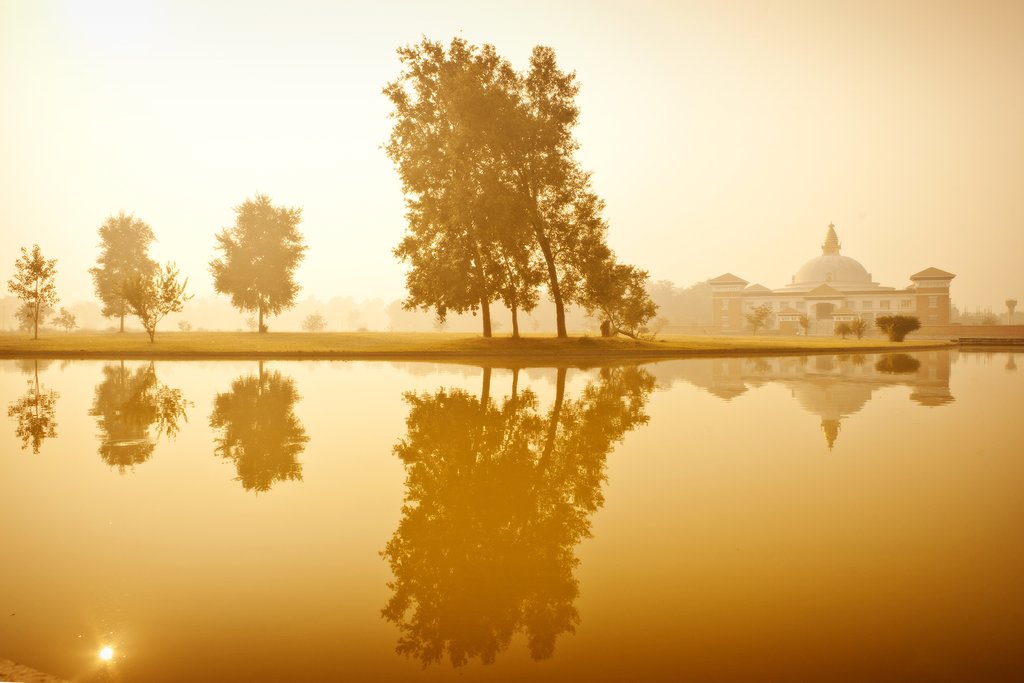History of Lumbini

Lumbini's global significance comes from the fact that Siddharta Gautama — later to be known as the Buddha, or "Awakened One" — was born here 2,500 years ago. A modest plaque and stone marks the exact spot where Queen Maya Devi grasped onto a bodhi tree branch and gave birth to this prince, en route to her home in Kapilavastu.
The site was lost to the world for over a millennium, as Hinduism and Islam supplanted Buddhism as the subcontinent's major faiths. It was only in the 19th century that a local Nepali governor (accompanied by Raj-era British archaeologists) rediscovered the site, largely by comparing the written descriptions of medieval Chinese pilgrims with inscriptions found on two-thousand-year-old sandstone pillars. Decked in marigolds and offerings, Ashoka's pillar still stands in front of the Maya Devi Temple, marking the high tide of Buddhism when it ruled as the dominant faith from Peshawar to Patna.
What to Expect

Today, the wider Lumbini complex — a grand three miles (4.8 km) long — is part of a huge UNESCO World Heritage Site. It consists of dozens of monasteries built by several Buddhist countries (all in their national styles), the sacred Bodhi tree, an ancient bathing pond, the renowned Ashokan pillar, and the Mayadevi Temple.
Perhaps unsurprisingly considering the religion's tenet of non-attachment, the temple complex at Lumbini is incredibly laid-back. You'll likely see a steady flow of pilgrims from Burma, Thailand, and China shuffling past the main shrine in hushed reverence, but the place never feels crowded. Nor is it a visually splendid place: a few brick stupa bases and ancient monastery walls remain (as does the pool in which the queen and her infant first bathed), but mostly the site is impressive for its spiritual significance. It is a place of meditation, contemplation, and deep reverence. Bling has no place in Buddhism.
How to Get There

Lumbini is a five-hour drive from Pokhara, or a short flight from Kathmandu to Bhairahawa, followed by a short drive. It's close to the Indian border, meaning it's easily combined with an onward journey through India's Uttar Pradesh state to the Buddhist pilgrimage sites of Kushinagar (where Buddha died) and Sarnath (where Buddha gave his first sermon), as well as the ever-fascinating sacred city of Varanasi.
When to Go

Lumbini is situated in the lowlands of Nepal's Terai plain, so it's best visited in the cooler winter months, from November to March. Hotels are limited in the area, so aim to make reservations well in advance. For more information, check out this article on when to visit Nepal. (And how to get your visa!)
Getting Around

Though you can certainly walk, you can also spend a wonderful half-day touring from one monastery to another on a rented bicycle.
Start at the impressive Burmese-style golden pagoda and continue past the amazingly ornate Cambodian temple to the Sri Lankan monastery, where monks offer pilgrims sacred white threads to tie around their wrists. You'll soon see a huge Tibetan-style stupa sitting next to a Chinese-style temple that looks like it's been lifted from Beijing's Forbidden City. It's a visual A-to-Z of Buddhist architectural styles, showing just how the faith adapted to local cultures as it spread through East Asia.
Beyond Lumbini: Other Places of Interest

Siddhartha was born a prince in the kingdom of Kapilavastu, and you can still wander the ruined city walls of his former palace — hire a taxi for the hour's drive east of the main shrine. Once there, head to the foundations of the Eastern Gate, and you'll be standing at the very spot where the 29-year-old prince cast off his robes and rode out of the city, turning his back on his wife and child to embark on a six-year search for enlightenment. It's an unassuming (yet pivotal) place of global historic importance.
Other archaeological sites nearby include two more pillars erected by Ashoka, marking the birthplace of previous Buddhas. At nearby Kundan, there are a further three stupas where the Buddha met his father, wife, and son for the first time after his enlightenment, and where he inducted his son into the fledgling Buddhist faith.
Returning to Lumbini, there's no better way to round off a trip than to spend a quiet hour in the grounds of the temple, reading an introduction to Buddhism, meditating, or just sitting quietly and absorbing the site. As travel experiences go, this may be as profound as it gets.
